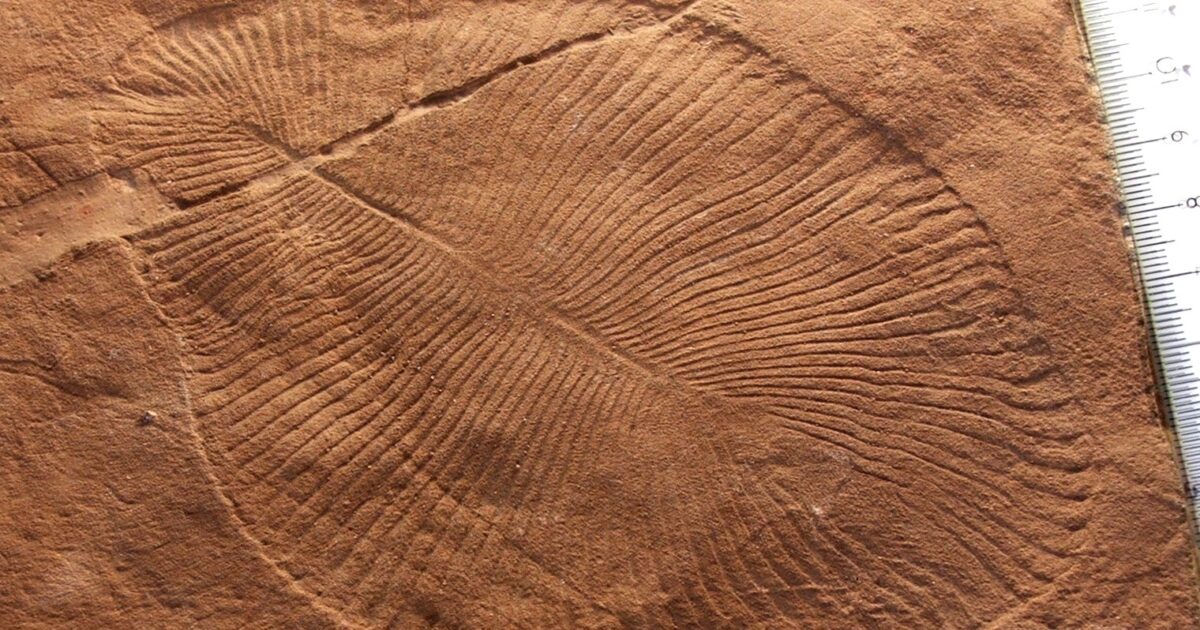 Evolution
Evolution
 Paleontology
Paleontology
Fossil Friday: Dickinsonia, the Ediacaran Animal that Wasn’t

Dickinsonia is one of the iconic Ediacaran organisms that lived prior to the Cambrian Explosion and reached the size of a large bath mat. Its affinity was long considered as highly problematic, but more recently several studies suggested an animal relationship. A while ago, I therefore published an article at Evolution News that was titled “Why Dickinsonia Was Most Probably Not an Ediacaran Animal” (Bechly 2018). In the article I discussed at length all the pro and con arguments, including evidence from trace fossils and from fossil sterol biomarkers. Now, we can slash the word “probable,” and definitely refute an animal nature.
The reason is a recent study by Retallack (2022) about damaged and regenerated specimens of Dickinsonia (compare Ivantsov et al. 2020), which show a growth pattern that is absolutely inconsistent with an animal relationship. Also, the images in this paper as well as the recent studies by Ivantsov et al. (2019a) and Ivantsov & Zakrevskaya (2022) clearly confirm that the apparent “segmentation” of Dickinsonia is not bilateral symmetric but exhibits glide reflection, which especially excludes a bilaterian animal relationship that was for example suggested by Gold et al. (2015) and ironically by Ivantsov et al. (2019a), who still emphasized that the glide symmetry is “atypical for the Bilateria.” Ivantsov & Zakrevskaya (2022) also show that this glide symmetry cannot be explained away as an artifact of preservation or as a difference between dorsal and ventral side. The latter authors still consider Dickinsonia and their relatives as metazoans, but they do not provide a single argument (e.g., a putative synapomorphy) for such an attribution. Instead they admit: “The presence of a thickened (or weakened) narrow axial zone, along which the displacement of the halves of the bilateral elements is possible, is extremely unusual for animals.“
Probably, their only reason for considering an animal nature is a highly speculative and dubious reconstruction of the integumental structure (Ivantsov et al. 2019a) as well as alleged new evidence for motility (e.g., Ivantsov et al. 2019b, Ivantsov & Zakrevskaya 2021). However, the evidence for motility is highly controversial and far from conclusive (see detailed discussion in Bechly 2018). Also, Ivantsov & Zakrevskaya (2021) explicitly emphasized that most specimens of Dickinsonia definitely adhered to the sea floor. Even if Dickinsonia was facultatively motile, this could at best suggest an extinct dead-end branch of placozoan or coelenterate grade below the origin of Bilateria, so that Dickinsonia could not be considered as a potential ancestor of the numerous bilaterian animal phyla appearing abruptly during the Cambrian Explosion — not by any stretch of the imagination. Anyway, the new developmental evidence presented by Retallack strongly suggests that the controversial trace fossil evidence for alleged motility needs to be reconsidered and reinterpreted, for example in terms of passive displacement by water current as was already suggested by several experts in the past.
It must be noted that Gregory Retallack is a kind of maverick paleontologist, who endorses a fringe hypothesis that Ediacaran organisms were not marine but terrestrial lichens. This is almost certainly false, as documented by autochtonous specimens in deep sea sediments from Mistaken Point in Canada. However, the main argument of the new study does not rely on such fringe views but has to be evaluated on the basis of the presented evidence, which is simply overwhelming against an animal nature in general and a bilaterian affinity in particular.
References
- Bechly G 2018. Why Dickinsonia Was Most Probably Not an Ediacaran Animal. Evolution News September 27, 2018. https://evolutionnews.org/2018/09/why-dickinsonia-was-most-probably-not-an-ediacaran-animal/
- Gold DA, Runnegar B, Gehling JG, Jacobs DK 2015. Ancestral state reconstruction of ontogeny supports a bilaterian affinity for Dickinsonia. Evolution & Development 17, 315–324. DOI: https://doi.org/10.1111/ede.12168.
- Ivantsov, AY & Zakrevskaya MA 2021. Dickinsonia: Mobile and adhered. Geological Magazine 159(special issue 7) 1118–1133. DOI: https://doi.org/10.1017/S0016756821000194.
- Ivantsov AY & Zakrevskaya M 2022. DICKINSONIA COSTATA of the Winter Mountains: Features of morphology and ontogenesis. Precambrian Research 379:106788, 1–16. DOI: https://doi.org/10.1016/j.precamres.2022.106788.
- Ivantsov AY, Zakrevskaya MA & Nagovitsyn AL 2019a. Morphology of integuments of the Precambrian animals, Proarticulata. Invertebrate Zoology 16(1), 19–26. DOI: https://doi.org/10.15298/invertzool.16.1.03.
- Ivantsov AY, Nagovitsyn AL & Zakrevskaya MA 2019b. Traces of locomotion of Ediacaran macroorganisms. Geosciences 9(9):395, 1–11. DOI: https://doi.org/10.3390/geosciences9090395.
- Ivantsov AY, Zakrevskaya MA, Nagovitsyn AL, Krasnova A, Bobrovskiy I & Luzhnaya (Serezhnikova) E 2020. Intravital damage to the body of Dickinsonia (Metazoa of the late Ediacaran). Journal of Paleontolology 94(6), 1019–1033. DOI: https://doi.org/10.1017/jpa.2020.65.
- Ivantsov AY, Fedonkin MA, Nagovitsyn AL & Zakrevskaya MA 2019. Cephalonega, A New Generic Name, and the System of Vendian Proarticulata. Paleontological Journal 53(5), 447–454. DOI: https://doi.org/10.1134/S0031030119050046.
- Retallack GJ 2022. Damaged Dickinsonia specimens provide clues to Ediacaran vendobiont biology. PLoS ONE 17(6): e0269638, 1–26. DOI: https://doi.org/10.1371/journal.pone.0269638.
